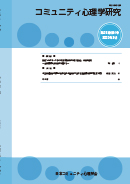
- Issue 2 Pages 45-
- Issue 1 Pages 1-
- |<
- <
- 1
- >
- >|
-
Ichin CHANG2022 Volume 26 Issue 1 Pages 1-20
Published: September 30, 2022
Released on J-STAGE: December 14, 2023
JOURNAL FREE ACCESSXiaolin Village in Taiwan’s Kaohsiung City was damaged by the Morakot Typhoon on August 8, 2009. This study evaluates the medium-to-long-term psychological recovery of the residents in the affected area. It assesses the psychological impact of the disaster on the community and analyzes the recovery process based on the subjective experiences shared by the residents. The study utilizes ethnography and encompasses a literature review, data analysis, participant observations, and interviews. It traces the process of reconstruction and psychological recovery through the opinion voiced by residents: their “dance group, culture, and industry” resulted in the reconstruction of their livelihoods and psychological recovery. Erikson’s (1976) conception of collective trauma partly exemplifies the psychological impact of the disaster on the Xiaolin community, as the mutual connections of residents were destroyed. At the same time, conflicts about their homeland emerged, and they confronted the loss of their other identities because their role as survivors was overestimated. Therefore, it does not suffice to investigate the traumatic symptoms triggered in individuals in the aftermath of a disaster. In conclusion, the affected groups must also regenerate community functions in a manner appropriate to their culture and undertake activities proactively to create a future lifestyle as a group.
View full abstractDownload PDF (856K)
-
Masato Kimura2022 Volume 26 Issue 1 Pages 21-28
Published: September 30, 2022
Released on J-STAGE: December 14, 2023
JOURNAL FREE ACCESSThis study aimed to investigate the relation between help-seeking intentions and institutional factors of College Student Counseling. Using conjoint analysis, we performed a questionnaire among 400 college students. The final analysis included 331 survey responses. The result indicated that the major factors affecting the preferences of students regarding student counseling centers were the appointment system and the gender of the counselor. The college students sampled most preferred walk-in counseling. They were most reluctant to make an appointment by telephone. Regarding the counselor’s gender, the college students preferred female counselors over male counselors. Implications for promoting the use of student counseling centers among Japanese undergraduates were discussed.
View full abstractDownload PDF (394K)
- |<
- <
- 1
- >
- >|